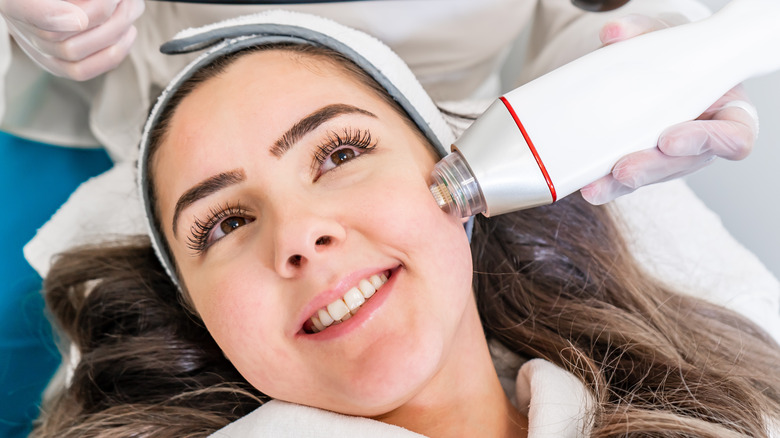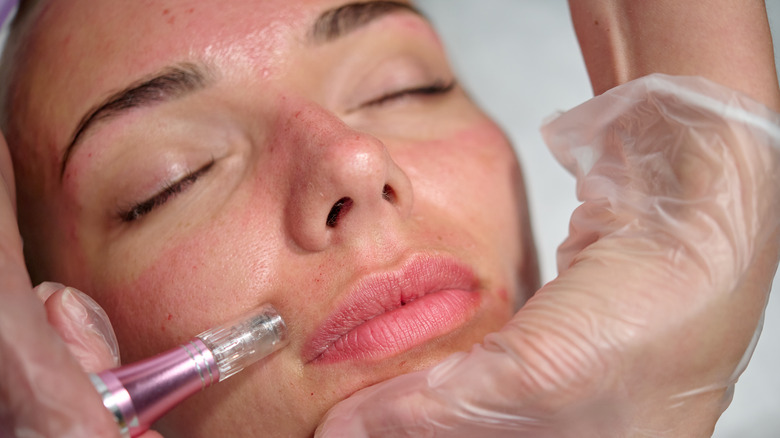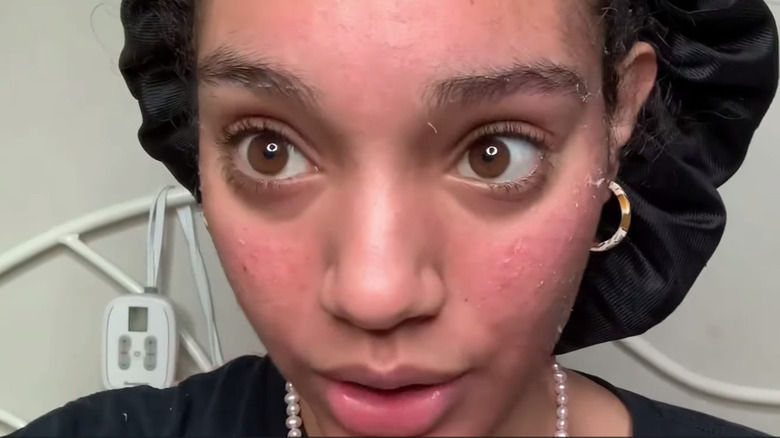Inside Radiofrequency Microneedling's Potential Side Effects
Radiofrequency microneedling is best known for producing dramatic results compared to just microneedling alone — a cosmetic procedure that pricks the skin with small needles to boost collagen production (via WebMD). In fact, a 2021 study in the Journal of Cosmetic Dermatology found that there was a reported satisfaction rate of 67% from individuals who underwent the procedure just once. Think of it as a more intense version of the original, where results tend to be much more noticeable and should last quite a long time, per Rashid Plastic Surgery. However, the treatment only began to gain traction within the beauty world when the much-loved Kourtney Kardashian revealed that she regularly underwent the similar procedure known as a "vampire facial."
Like many cosmetic treatments, radiofrequency microneedling comes with an array of benefits, such as smoother, firmer-looking skin, reduced appearance of scarring, and overall younger-looking skin. However, the treatment has side effects like any cosmetic and medical procedure. This is part and parcel of most treatments within the medical field. We'll take a look at some of the potential side effects of radiofrequency microneedling and see if there's anything you can do to minimize their impact.
Side effects from radiofrequency microneedling are usually minor
If you're considering a radiofrequency microneedling treatment, then you may be concerned about the potential side effects. Of course, your safety is one of the most important things to take into consideration before getting any cosmetic procedure. Thankfully, most of the side effects from radiofrequency microneedling are usually minor, and should only last a few days at most. Some of the most common include mild swelling, some redness, dryness of the skin, and even some mild acne (via Healthline). You may even experience some itching during the treatment, but it's usually nothing to worry about.
Another side effect you may experience is minor skin scabbing in the treated area. "You may also develop mild, tiny crusts on the target area after the procedure," medical esthetician Tamila Deveny explains to Byrdie. "The dermatologists recommend not picking the scabs with your bare hands, and instead letting them fall off on their own." Deveny added that patients may also experience cold sores post-treatment, but these can be prevented with medication for those who are susceptible.
When to see a doctor for your side effects
In most cases, these side effects may last anywhere from a few hours to a few days, which is completely normal. If your side effects last for considerably longer or seem to be getting more serious, you should get in touch with your doctor, who should be able to resolve things. Some side effects to look out for that may instigate such a call include your symptoms lasting much longer than is typically usual, headaches, prolonged bruising, or if you suspect that you may have an infection, per Healthline.
To minimize your risk of these side effects, there are some steps that you can take. A week before your treatment, you should avoid blood thinning medications and avoid using products like retinol on your skin (via My Cosmetic Clinic). Okanagan Skin Centre also recommends "avoiding anti-inflammatory medications such as ibuprofen, Motrin, or Advil for at least three days prior." These precautions will all help the treatment to go as smoothly as possible.
If you want personalized advice about what to avoid, a healthcare professional or the individual performing the procedure should be able to give you some helpful recommendations.


